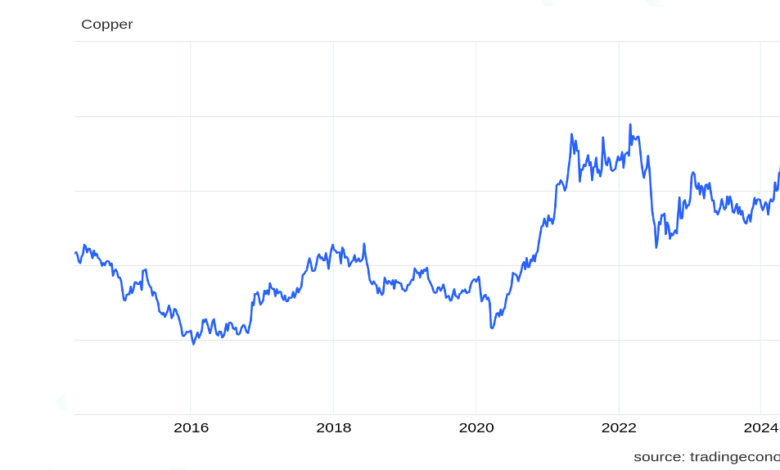Why tokenized commodities matter today | by Jonny Fry | May, 2024

Written by Philipp Pieper, Co-Founder of Swarm, a compliant RWA platform
Historically, commodity markets have shown high volatility during periods of geopolitical conflict. This phenomenon arises from the supply shocks that such events generate, impacting the production of and demand for commodities. Recently, global attention has been drawn to conflicts involving Russia and Ukraine, and tensions that have escalated between Israel and Hamas in the Middle East. Fluctuations in the price of copper exemplify the impact of these conflicts on commodity markets. Volatility from these conflicts means copper is nearing its historical all-time high of $10,845 per tonne, with some reports suggesting it could go as high as $15,000.
During periods of geopolitical tension, gold serves as a safe-haven asset for investors seeking to protect their portfolios. This sentiment is mirrored in the price of gold, which surged from around $1,800 in October 2023 to nearly $2,400 by May 2024, reflecting a heightened demand during conflict escalations. Commodities are among the most traded asset classes worldwide but the way they have been traded remains largely unchanged for decades. Hence, in this piece we will explore how tokenization can change the way commodities are accessed, traded and leveraged, plus how it can solve some of the problems commodities markets face, including double spending.
Addressing double-spending in commodities
Double-spending is when the same physical commodity — barrels of oil or sheets of copper — is borrowed against, several times over, to secure credit from multiple providers. A notable example of this issue was the Qingdao scandal. The Qingdao scandal involved Dezheng Resources issuing fake warehouse receipts for metals such as aluminium and copper. These fake receipts, used as collateral for financing from various tier one banks and financial institutions, allowed Dezheng to secure billions in funding. If there was a default on the loan, who would get the metal? Following this event, there was a tightening of credit in metal transactions, improvements in warehouse receipt security, and legal disputes to recover losses. The scandal reflects the “double-spending” challenge that blockchain technology sought to mitigate upon its inception — create an immutable database where value can be moved around, and ownership recorded in a transparent way. The same token cannot be used in multiple lending and borrowing protocols, which removes the risk of double spending. However, tokenization has its own set of problems. The attestation process needs to be watertight so that token holders trust their tokens pertain to the physical commodity that is supposed to be backing them.
Gold on chain
Gold has a market cap nearing $16 trillion. Its popularity as a safe-haven asset illustrates why it was one of the first real world assets to be tokenized on-chain. Amidst the volatility of the crypto market, it serves as a beacon for investors seeking stability and non-inflationary assets, allowing for portfolio diversification and offers an exit plan when markets, inevitably, crash. There are gold products currently available on public blockchain platforms; however, the predominant offerings are not fully decentralized, with centralized entities retaining a lot of control over the assets backing those tokens, which can be changed at their discretion. Additionally, these products face limitations regarding physical redeemability and tradability. The DeFi community needs gold product options that are more transparent and flexible than what is available today. In March 2024, HSBC launched a tokenized gold product which is available for retail investors.
Who benefits from gold moving on-chain?
· Retail investors
In traditional markets, retail investors find challenges accessing gold and other commodities securely. Some navigate the complexities of CFDs (contracts for differences), a synthetic derivatives contract, but these should only really be used by experienced traders and do not give direct exposure to the underlying asset. The advent of a Gold ETF was innovative for enabling more retail investor access to this asset class. So why go for a tokenized version? The answer to that depends on where you sit in the world. ETFs are widely accessible to investors in the West, but not so much in emerging markets. Tokenized gold sits on a global infrastructure that can be accessed by anyone who has a wifi connection and crypto wallet. You can do more with your tokenized asset. Securing credit by borrowing against your assets is usually only reserved for high net worths or institutional investors. The advent of DeFi changes that, making lending and borrowing for smaller investors possible.
· Institutional investors
For institutions, tokenized gold offers enhanced transparency and flexibility compared to conventional means of access. By bringing gold into one blockchain infrastructure, this asset class is no longer siloed. In traditional finance, investors often need to onboard different venues to trade multiple asset classes, resulting in the need to manage portfolio risks across various platforms. Moreover, integrating all types of asset classes into a single infrastructure brings modular and atomic advantages. This consolidation allows for the development of novel products and facilitates reaching new audiences in different jurisdictions.
Finally, fractionalization gives institutions greater flexibility. Current commodities futures contracts are rigid with pre-defined tonnage and prompt date structures. Tokenization enables more precise hedging and risk-management thanks to fractionalization, giving market participants greater control. While the concept of blockchain tokenization may seem abstract at first, it has concrete applications, such as preventing incidents like the Qingdao Scandal and fostering a more inclusive and efficient commodities trading ecosystem. As highlighted earlier, gold serves as a safe-haven asset for investors during periods of political tension, offering a means to safeguard their portfolios. Facilitating seamless access to gold through the blockchain extends its reach globally, particularly benefiting individuals in developing countries struggling with high inflation and political volatility. The case for flexible, tradable and redeemable tokenized gold has never been more important than now.





